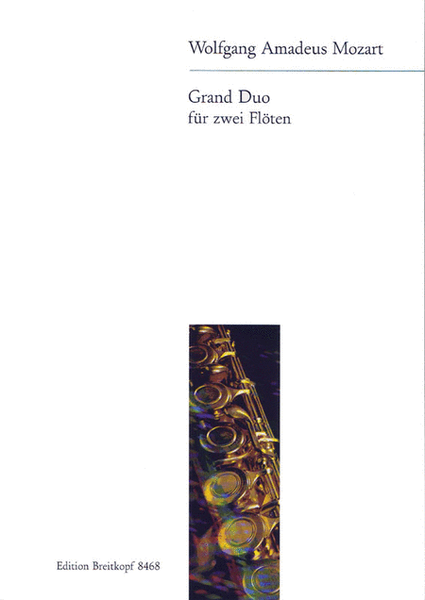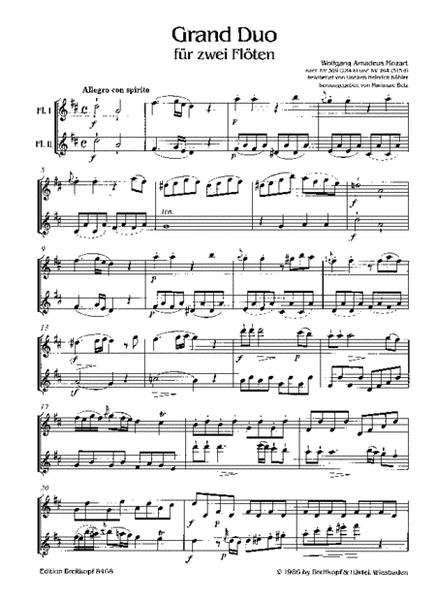Grand Duo from K. 309 and 264
-
Ships in 3 to 4 weeks
Details
Description
SKU: BR.EB-8468
Composed by Wolfgang Amadeus Mozart. Edited by G. H. Kohler and Marianne Betz. Solo instruments; Softcover. Edition Breitkopf. Arranged after the Piano sonata KV 309 (284 b) and the Variations Lison dormait KV 264 (315 d) by Gottlied Heinrich Kohler, in his day a famous flutist. Classical period. Score. 32 pages. Breitkopf and Haertel #EB 8468. Published by Breitkopf and Haertel (BR.EB-8468).ISBN 9790004177648. 9 x 12 inches.
Arranged after the Piano sonata KV 309 (284 b) and the Variations Lison dormait KV 264 (315 d) by Gottlied Heinrich Kohler, in his day a famous flutist. Sabine Meyer Wolfgang Meyer und Reiner Wehle die Mitglieder des Trio di Clarone haben bei ihrer Neuausgabe einige dieser Anderungen dem Autograph Mozarts angepasst. Die Spielbarkeit des A-dur-Konzerts wird von der kritischen Revision naturlich nicht beeintrachtigt. Die Original-Kadenzen finden Sie unter Mozart 36 Kadenzen zu eigenen Klavierkonzerten. Die Ausgabe EB 8577 Busoni Kadenzen zu W. A. Mozarts Klavierkonzerten enthalt ebenfalls Kadenzen zum Klavierkonzert Es-dur KV 271.
EB 8640 ist in Partitur gedruckt; zur Auffuhrung werden zwei Exemplare benotigt.
Die brillante, inspirierte Einspielung von Robert Levin (mit Christopher Hogwood und der Academy of Ancient Music) und die Breitkopf-Neuausgabe haben zweierlei gemeinsam: die historisch fundierte Herangehensweise und das Herausgeberteam Robert Levin und Cliff Eisen. Urtext bedeutet hier den Verzicht auf eine Fassung letzter Hand, die es nie gegeben hat und die Mozart selbst nie im Sinn hatte. Vielmehr folgen Levin und Eisen einer auf Mozart zugeschnittenen Editionsphilosophie: Standardisierung stellt die grosse asthetische Bedrohung fur Auffuhrungen der Mozart-Konzerte dar. Die Neuausgabe, fur deren Partitur erstmals das in Krakow aufbewahrte Autograph herangezogen wurde, geht deutlich uber den Kenntnisstand aller bisherigen Ausgaben einschliesslich der NMA hinaus. Gleichzeitig bieten Partitur und Klavierauszug eine Fulle an zusatzlichen auffuhrungspraktischen Informationen, die sich aus weiteren authentischen Quellen ergeben, u. a. zu Continuo-Praxis, Instrumentarium, Orchestergrosse und -aufstellung, Verzierungen, Tempo/Charakter, Kadenzen/Eingangen.
You will find the original cadenzas under Mozart 36 Cadenzas for his own Piano Concertos. The edition EB 8577 Busoni Cadenzas for W. A. Mozart's Piano Concertos also contains cadenzas for the Piano Concerto in E flat major K. 271.EB 8640 is printed in score form; two copies are needed for performance.
Robert Levin's brilliant and inspired recording (with Christopher Hogwood and the Academy of Ancient Music) and Breitkopf's new edition have two things in common: their historically well-founded approach and the editorial team consisting of Robert Levin and Cliff Eisen. Here, Urtext signifies an eschewal of a final version that never existed and that Mozart himself had never even envisaged. On the contrary, Levin and Eisen pursue an editorial philosophy tailored to Mozart and his music: Standardization is the greatest aesthetic threat in the performance of Mozarts concertos. To prepare the score of the new edition, the editors were able to consult the autograph, located in Krakow, for the very first time. The new edition clearly incorporates a much broader base of findings than any previous edition, including the NMA. At the same time, the score and piano reduction offer a wealth of additional information on performance practice gleaned from further authentic sources, including observations on continuo practice, instruments, size and disposition of the orchestra, ornaments, tempo and character, cadenzas and flourishes.


 Share
Share